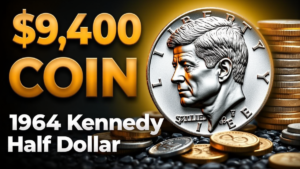1918/7-D Buffalo Nickel – A Rare and Priceless Heritage
1918/7-D Buffalo Nickel is a historical past in the international of rare coins, which is known for its ancient and creative splendor. Minted at Denver Mint, this coin may be very particular not best due to its precise format however additionally because of rarity and ancient mistake. Recently it become offered in an auction for $450,000 (approximately Rs 4 crore), making it one of the most treasured and collectible coins in American history.
A coin, which hides a secret
Buffalo Nickel was designed by James Earle Fraser in 1913. The design reflects American history and culture:
- Obverse: A portrait of a robust and amazing Native American Chief, honoring the indigenous human beings of america.
- Reverse: An American bison, frequently called a “buffalo,” stands on a mound. The layout symbolizes American western civilization and freedom.
What makes the 1918/7-D Buffalo Nickel special is its overdate error.
What is an overdate error?
This coin has a faint “7” under the “8” in the 1918 date. This mistake happened when an old 1917 die was reused and the date 1918 was engraved on it. This small mistake made this coin extremely rare and valuable.
Rarity of 1918/7-D Buffalo Nickel

This coin is one of the rarest and most precious cash of the Buffalo Nickel collection.
- Its low mintage
- Overdate mistake, which made it even rarer
- Decrease in the number of coins over time
For some of these motives, this coin has end up a treasured treasure for creditors today.
Its recent sale for $450,000 proved that excessive-grade cash can command sky-excessive charges.
The biggest prize for collectors
For coin creditors, the 1918/7-D Buffalo Nickel holds a special place.
- It is particular in terms of design.
- Its historical mistake makes it more interesting.
- Mint-state coins available in good condition are very rare.
- This is the reason its price reaches millions of dollars in auction.
But how much can this coin be worth in what condition?
Current price of 1918/7-D Buffalo Nickel
The price of this coin depends on how good condition it is in.
- Circulated Coins:
If the coin has been in movement and is gently worn, it can be really worth $5,000 to $50,000. - Uncirculated Coins:
If the coin is in mint-country (MS-60 or above), it could be really worth $100,000 to $250,000. - Extremely Rare High-Quality Coins:
If the coin is in mint circumstance, without scratches, with an ideal shine, it may be worth $450,000 or more
A glimpse of history
The 1918/7-D Buffalo Nickel is not just a coin, but a symbol of history.
- Time of 1918: America was recovering from World War I and entering a new era.
- Error at Denver Mint: The coin production process of that time was not fully advanced technology, which led to such overdate error.
- Importance today: This coin has become a symbol of history, art and culture of the United States.
Combination of beauty and rarity

The 1918/7-D Buffalo Nickel still remains a priceless heritage for coin collectors around the world.
- Its great design
- Rarity and overdate error
- Historical significance
All of this makes it an incredibly valuable coin.
Do you have this coin?
If yes, then it can be a priceless treasure for you, whose value can increase even more with time.
Are you fond of coin collecting?
If sure, then coins like 1918/7-D Buffalo Nickel are a have to have to your collection.
This coin isn’t just a piece of metal, but an essential chapter in American history.
FAQs
Why is the 1918/7-D Buffalo Nickel so valuable?
It features an overdate error, where the 1917 date was mistakenly re-punched with 1918, making it one of the rarest Buffalo Nickels.
How much is a 1918/7-D Buffalo Nickel worth today?
Values range from $5,000 in lower grades to nearly $400,000 for high-grade, well-struck specimens.
How can you identify the 1918/7-D overdate error?
Look closely at the last two digits—traces of the underlying “7” can be seen beneath the “8.”


